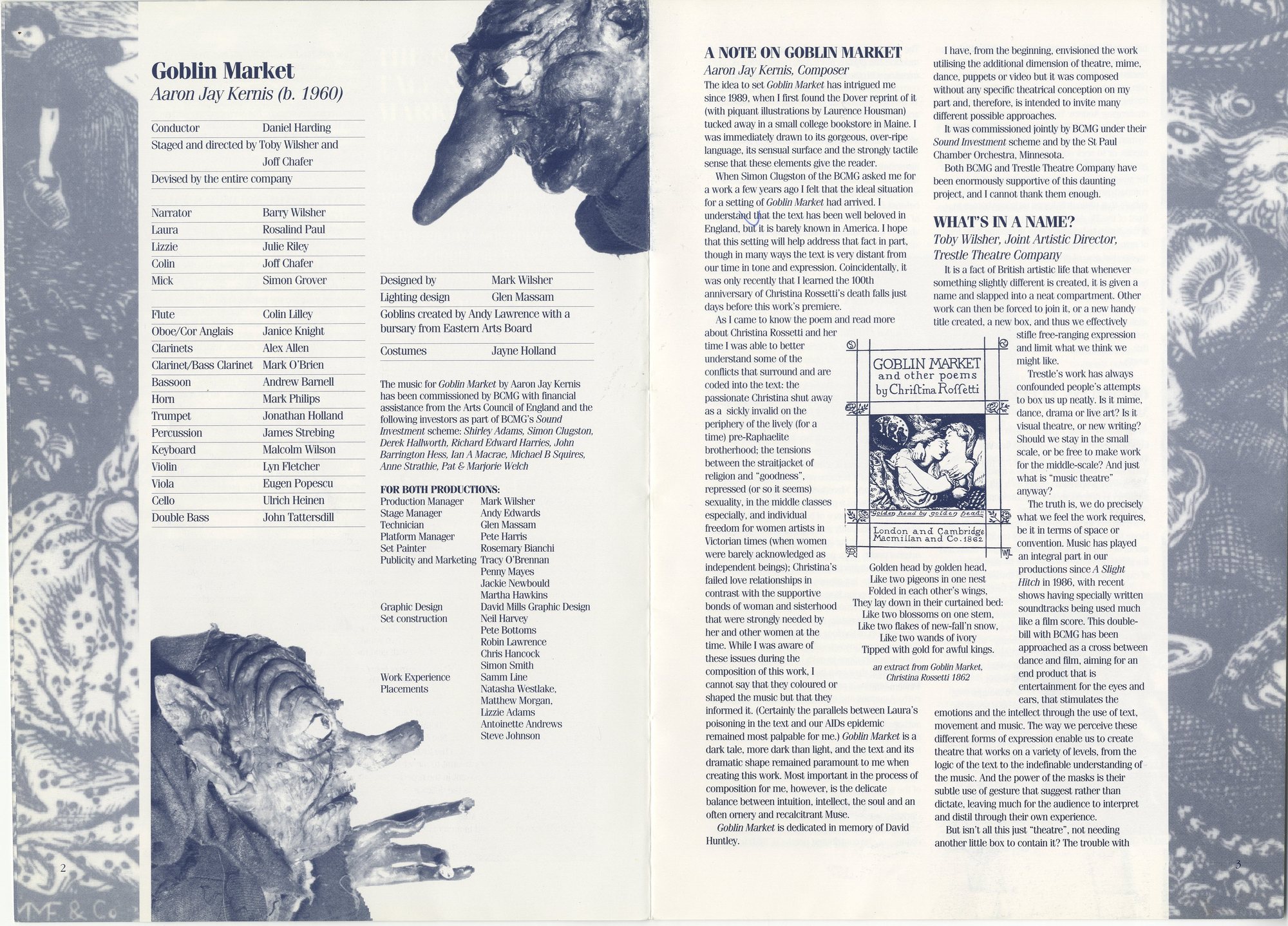Performance History
debut tour
Goblin Market’s first performance took place 12 January 1995 at The Music Hall, Shrewsbury, England, in a production presented by the Birmingham Contemporary Music Group and Trestle Theatre Company, with Daniel Harding as conductor. The first U.S. performance took place on 17 May 1996 at Ordway Music Theatre in Saint Paul, performed by the Saint Paul Chamber Orchestra under Hugh Woolf, conductor (Kernis, Title Page, Goblin Market).
In her biography of composer Aaron Jay Kernis, Leta E. Miller writes of Goblin Market's debut tour:
Commissioned by the Birmingham Contemporary Music Group, the piece began its performance life with a nine-city tour of England (January 12–22, 1995), including a performance at the Queen Elizabeth Hall in London and others in Shrewsbury, Barnstaple, Bath, Blackpool, Lancaster, York, Leicester, and Birmingham, all in halls appropriately suited for a chamber opera. (Audiences ranged from 180 to 471 for a total of 3,313 for the run.) The Birmingham ensemble presented a staged version of the piece, collaborating with the Trestle Theatre Group. They modernized the setting, portraying the sisters as drugged runaways taking shelter in a fruit and vegetable warehouse. Laura’s encounter with the goblins became a hallucination. (p. 80)
a “new writing” through mime
In her study of Christina Rossetti and Illustration, Lorraine Janzen Kooistra gives more detail about this staged production. The Trestle Theatre’s staging of Goblin Market amounts to an updating and a “new writing” (p. 270) of Rossetti’s poem. This production “stages Goblin Market as a confrontation between two sisters and two brothers who perform the action in mime to Kernis’s score” (Kooistra, p. 272) while a narrator speaks Rossetti’s entire poem, timed precisely to the music according to rhythmic notation in the score. The mime element enacts Goblin Market as “a story of teenage pregnancy, delinquency, drugs and AIDS, while at the same time keeping components of the original ethos with girls in sheer white dresses and long hair” (Fallows, qtd in Kooistra, p. 272). Meanwhile, a review of the London premiere of Kernis's Goblin Market at Queen Elizabeth Hall mentions that the Trestle Theatre production "locates the work in a contemporary dystopia where the women are squatters hoping to domesticate a fruit-and-veg warehouse haunted by goblin barrow-boys: the production moves easily between contemporary minutiae and profound archetypes” (Kimberley).
This production must have challenged audiences, who would be called upon to simultaneously listen to and follow the narrated poem, appreciate the music, and absorb visually the modernized dramatization in mime. Some reviewers criticized the interaction of speech and music demanded in the work: Alistair Macaulay wrote in the Times of London that Kernis’s form itself was “problematic” and that “Listeners have to choose between paying attention to text or music” (Macaulay, qtd in Miller, p. 80). Biographer Leta E. Miller acknowledges “Indeed, making the text entirely comprehensible without subordinating the musical score to the background is an extremely difficult task. Kernis’s success is laudatory, but he himself may have realized the form’s inherent dangers and ultimately irreconcilable demands. Since Goblin Market he has not written any other works with spoken narration” (Miller, p. 81).
as a concert work
Later performances of Goblin Market would forego the staging and present the piece as a concert work; but even without staging, the music and spoken text have a dramatic intensity and impact on audiences, as reviewers continually attest to. See for example, this review of a 2004 performance in Chicago:
The composer calls his melodrama--based on a Victorian tale by Christina Rossetti--a "mini-Wagnerian music drama." It is really a darkly Freudian fable about two virtuous sisters, Laura and Lizzie, one of whom succumbs to forbidden fruit proffered by goblins...the score teems with pictorially suggestive activity as creepy and riotous as the goblins it depicts...a fun entertainment fueled by much shrewd musical invention. (von Rhein)
Other reviewers rave as well: “And what a story! Intoxicating, outrageous, unforgettable: it is no exaggeration to say that Goblin Market is one of the great musical works of art for theatre of the 20th century” (Byzantion). Clearly, even when performed as a concert work, the composition’s dramatic and theatrical aspects have an impact.
Acknowledgment:
I would like to thank Dr. Lorraine Janzen Kooistra, Ryerson University, for generously sharing with the Christina Rossetti in Music project her personal collection of primary materials related to stage productions of "Goblin Market."
Sources:
Byzantion. Review of Goblin Market: Aaron Jay Kernis; The New Professionals; Mary King Narrator; Rebecca Miller Conductor, Signum Records, 2011. MusicWeb International. Accessed 11 March 2016. https://www.arkivmusic.com/classical/album.jsp?album_id=542544&album_group=1).
Fallows, David. “BCMG/The Goblin Market.” Review of performance of Aaron Jay Kernis's Goblin Market. Guardian, 19 January 1995.
Kernis, Aaron Jay. Title Page. Goblin Market. Associated Music Publishers, 1996.
Kimberley, Nick. “Rossetti grows on you.” Review of performance of Aaron Jay Kernis's Goblin Market. Independent, 21 January 1995.
Kooistra, Lorraine Janzen. Christina Rossetti and Illustration: A Publishing History. Athens, OH, Ohio UP, 2002.
Macaulay, Alastair. “Attitudes in Slow-Motion: Colourful and Decadent.” Review of performance of Aaron Jay Kernis's Goblin Market. The Times (London), 16 January 1995.
Miller, Leta E. Aaron Jay Kernis. Champaign, IL, U of Illinois P, 2014.
von Rhein, John. Review of performance of Aaron Jay Kernis's Goblin Market. Chicago Tribune, 12 May 2004.


